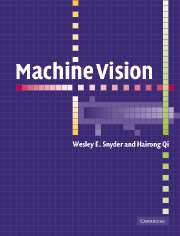Book contents
- Frontmatter
- Contents
- To the instructor
- Acknowledgements
- 1 Introduction
- 2 Review of mathematical principles
- 3 Writing programs to process images
- 4 Images: Formation and representation
- 5 Linear operators and kernels
- 6 Image relaxation: Restoration and feature extraction
- 7 Mathematical morphology
- 8 Segmentation
- 9 Shape
- 10 Consistent labeling
- 11 Parametric transforms
- 12 Graphs and graph-theoretic concepts
- 13 Image matching
- 14 Statistical pattern recognition
- 15 Clustering
- 16 Syntactic pattern recognition
- 17 Applications
- 18 Automatic target recognition
- Author index
- Index
3 - Writing programs to process images
Published online by Cambridge University Press: 05 June 2012
- Frontmatter
- Contents
- To the instructor
- Acknowledgements
- 1 Introduction
- 2 Review of mathematical principles
- 3 Writing programs to process images
- 4 Images: Formation and representation
- 5 Linear operators and kernels
- 6 Image relaxation: Restoration and feature extraction
- 7 Mathematical morphology
- 8 Segmentation
- 9 Shape
- 10 Consistent labeling
- 11 Parametric transforms
- 12 Graphs and graph-theoretic concepts
- 13 Image matching
- 14 Statistical pattern recognition
- 15 Clustering
- 16 Syntactic pattern recognition
- 17 Applications
- 18 Automatic target recognition
- Author index
- Index
Summary
Computer Science is not about computers any more than astronomy is about telescopes
E. W. DijkstraOne may take two approaches to writing software for image analysis, depending on what one is required to optimize. One may write in a style which optimizes/minimizes programmer time, or one may write to minimize computer time. In this course, computer time will not be a concern (at least not usually), but your time will be far more valuable. For that reason, we want to follow a programming philosophy which produces correct, operational code in a minimal amount of programmer time.
The programming assignments in this book are specified to be written in C or C++, rather than in MATLAB or JAVA. This is a conscious and deliberate decision. MATLAB in particular hides many of the details of data structures and data manipulation from the user. In the course of teaching variations of this course for many years, the authors have found that many of those details are precisely the details that students need to grasp in order to effectively understand what image processing (particularly at the pixel level) is all about.
Image File System (IFS) software
The objective of quickly writing good software is accomplished by using the image access subroutines in IFS. IFS is a collection of subroutines and applications based on those subroutines which support the development of image processing software. Advantages of IFS include the following.
- Type
- Chapter
- Information
- Machine Vision , pp. 29 - 37Publisher: Cambridge University PressPrint publication year: 2004



